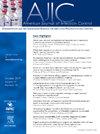2017-2022年纽约2019冠状病毒病大流行之前和期间耳念珠菌患者的特征分析
IF 2.4
3区 医学
Q2 INFECTIOUS DISEASES
引用次数: 0
摘要
背景:耳念珠菌是一种多重耐药菌,可引起严重的侵袭性感染。我们在COVID-19大流行之前和期间对纽约的金黄色葡萄球菌流行病学进行了表征。方法:将多个全州数据库连接起来,评估auris筛查病例(进行定殖筛查的患者)和临床病例(进行疾病诊断的患者)的人口学和临床特征以及结果。将2017-2022年诊断的病例分为四个阶段进行比较,包括covid -19前期、第一波、持续缓解和疫苗时代。联合点分析用于评估临床病例的月百分比变化(MPC)和显著的时间趋势。结果:在第一波中,黑人和西班牙裔患者(临床和筛查)、来自高社会脆弱性指数社区(临床)的患者(临床)和老年患者中auris病例的比例较高。结论:COVID-19住院治疗的涌入可能推动了临床和筛查auris病例特征的转变。2017-2022年临床耳c菌发病率呈上升趋势,但发病期间及发病后发病率斜率未增加。本文章由计算机程序翻译,如有差异,请以英文原文为准。
Characterization of patients with Candida (Candidozyma) auris before and during the COVID-19 pandemic in New York, 2017-2022
Background
Candida auris causes severe, invasive infections. We characterized C. auris epidemiology in New York before and during the coronavirus disease 2019 (COVID-19) pandemic.
Methods
Multiple statewide databases were linked to assess demographic and clinical characteristics and outcomes among C. auris screening cases (patients tested for colonization screening) and clinical cases (patients tested to diagnose disease). Cases diagnosed during 2017–2022 were divided into four phases (pre-COVID-19, first wave, ongoing mitigation, and vaccine era ) and compared. Joinpoint analysis was used to assess monthly percentage change (MPC) and temporal trends among clinical cases.
Results
During the first wave, higher proportions of C. auris cases were among Black and Hispanic patients (clinical and screening), patients from high social vulnerability index neighborhoods (clinical), and patients aged < 60 years (screening), compared with pre-COVID-19. Increased proportions of Hispanic patients and those aged < 60 years among screening cases persisted through ongoing mitigation and vaccine era. MPC of clinical cases was stable throughout the analysis period (1.97%), and there were no significant joinpoints.
Conclusions
COVID-19 hospitalizations might have driven shifts in characteristics of clinical and screening C. auris cases. Clinical C. auris incidence increased during 2017–2022, but the incidence slope did not increase.
求助全文
通过发布文献求助,成功后即可免费获取论文全文。
去求助
来源期刊
CiteScore
7.40
自引率
4.10%
发文量
479
审稿时长
24 days
期刊介绍:
AJIC covers key topics and issues in infection control and epidemiology. Infection control professionals, including physicians, nurses, and epidemiologists, rely on AJIC for peer-reviewed articles covering clinical topics as well as original research. As the official publication of the Association for Professionals in Infection Control and Epidemiology (APIC)

 求助内容:
求助内容: 应助结果提醒方式:
应助结果提醒方式:


